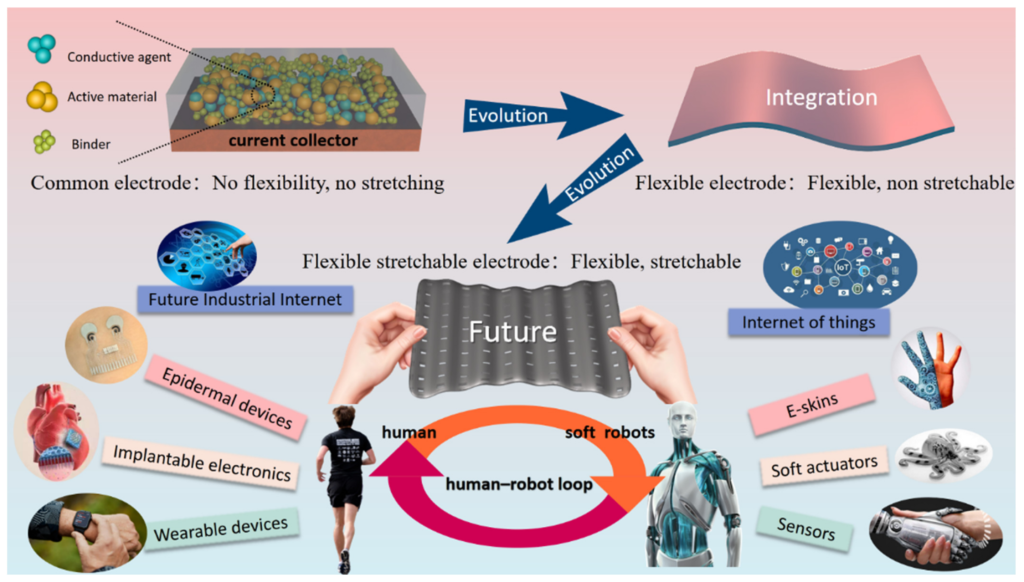The rapid advancement of flexible electronics has revolutionized various industries, from consumer electronics to healthcare and beyond. At the heart of this innovation are advanced materials that enable electronic devices to be bendable, stretchable, and lightweight, while maintaining high performance and durability. This blog delves into the key materials driving the development of flexible electronics, their unique properties, applications, and the future potential of this transformative technology.
Flexible electronics rely on a range of advanced materials, each playing a crucial role in ensuring the devices’ functionality and flexibility. One of the most prominent materials in this field is organic semiconductors. These materials, made of carbon-based molecules or polymers, offer several advantages over traditional inorganic semiconductors like silicon. Organic semiconductors are inherently flexible, lightweight, and can be processed at low temperatures, enabling the fabrication of electronics on plastic substrates. These properties make them ideal for applications in flexible displays, sensors, and wearable devices.
Another critical material in flexible electronics is graphene. This single layer of carbon atoms arranged in a hexagonal lattice has exceptional electrical, thermal, and mechanical properties. Graphene’s high conductivity and flexibility make it a perfect candidate for transparent electrodes, transistors, and flexible batteries. Its strength and thinness also contribute to the durability and lightweight nature of flexible electronic devices. Researchers are continuously exploring new ways to incorporate graphene into electronic components, pushing the boundaries of what flexible electronics can achieve.
In addition to organic semiconductors and graphene, other two-dimensional (2D) materials like molybdenum disulfide (MoS2) are gaining attention in the field of flexible electronics. MoS2 is a transition metal dichalcogenide (TMD) that exhibits excellent semiconductor properties, making it suitable for use in transistors and sensors. Its flexibility and mechanical strength allow it to be integrated into flexible substrates, contributing to the development of high-performance, bendable electronic devices.
Conductive polymers also play a significant role in flexible electronics. These polymers, such as PEDOT:PSS (poly(3,4-ethylenedioxythiophene) polystyrene sulfonate), are electrically conductive and can be processed into thin, flexible films. Conductive polymers are used in a variety of applications, including flexible touchscreens, wearable sensors, and bioelectronics. Their biocompatibility also makes them suitable for medical devices and implants, opening new possibilities for healthcare innovations.
The combination of these advanced materials enables the creation of flexible electronic devices with a wide range of applications. One of the most visible applications is in flexible displays, which are used in smartphones, tablets, and wearable devices. These displays can be bent or rolled without compromising image quality, offering greater design flexibility and durability. Companies like Samsung and LG have already introduced commercial products with flexible OLED displays, showcasing the potential of this technology.
Wearable electronics are another significant application of flexible materials. Fitness trackers, smartwatches, and health monitoring devices benefit from the lightweight, flexible nature of advanced materials, making them more comfortable and convenient for users. Flexible sensors embedded in clothing or directly on the skin can monitor vital signs, physical activity, and environmental conditions, providing real-time data for personal health management and medical diagnostics.
Flexible electronics are also making strides in the field of energy storage and harvesting. Flexible batteries and supercapacitors, made with advanced materials like graphene and conductive polymers, offer high energy density and mechanical flexibility. These energy storage solutions can be integrated into wearable devices, flexible displays, and other portable electronics, ensuring a reliable power supply while maintaining device flexibility. Additionally, flexible solar cells can be used to harvest energy from the sun, powering electronic devices sustainably and efficiently.
Despite the significant progress in flexible electronics, several challenges remain. One of the main hurdles is ensuring the long-term reliability and durability of flexible devices. Repeated bending and stretching can cause material fatigue and degradation, affecting device performance over time. Researchers are actively working on developing more robust materials and improving fabrication techniques to enhance the durability of flexible electronics.
Another challenge is the integration of flexible components with traditional rigid electronic systems. Seamlessly combining flexible and rigid elements requires innovative design approaches and advanced packaging technologies. Ensuring compatibility and efficient communication between different components is crucial for the overall functionality and performance of flexible electronic devices.
Looking ahead, the future of flexible electronics is incredibly promising. Advances in materials science, combined with innovations in device fabrication and integration, will continue to drive the development of new applications and products. As flexible electronics become more prevalent, they will transform various industries, from consumer electronics and healthcare to energy and environmental monitoring.
Advanced materials are the backbone of flexible electronics, enabling the creation of bendable, stretchable, and lightweight devices with high performance and durability. Organic semiconductors, graphene, 2D materials, and conductive polymers are among the key materials driving this technological revolution. With ongoing research and development, flexible electronics will continue to expand their applications, offering innovative solutions and transforming how we interact with technology in our daily lives.
By Our Media Team
Our Editorial team comprises of over 15 highly motivated bunch of individuals, who work tirelessly to get the most sought after curated content for our subscribers.




